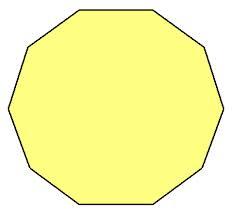Ten Sided Regular Polygon
 A regular polygon of
1
0
sides is constructed. In how many ways can
3
vertices be selected so that no two vertices are consecutive ?
A regular polygon of
1
0
sides is constructed. In how many ways can
3
vertices be selected so that no two vertices are consecutive ?
The answer is 50.
This section requires Javascript.
You are seeing this because something didn't load right. We suggest you, (a) try
refreshing the page, (b) enabling javascript if it is disabled on your browser and,
finally, (c)
loading the
non-javascript version of this page
. We're sorry about the hassle.
3 solutions
Nice methods sir.
Brilliant logic Sir
Total number of ways of choosing 2 consecutive vertices is 1 0 : ⎩ ⎪ ⎪ ⎪ ⎪ ⎪ ⎪ ⎪ ⎪ ⎪ ⎪ ⎪ ⎪ ⎪ ⎨ ⎪ ⎪ ⎪ ⎪ ⎪ ⎪ ⎪ ⎪ ⎪ ⎪ ⎪ ⎪ ⎪ ⎧ ( 1 , 2 ) ( 2 , 3 ) . . . . ( 9 , 1 0 ) ( 1 0 , 1 ) .
Now,for each of the above cases,we have 6 choices for the 3 r d vertex because we are counting the number of ways in which to choose 2 consecutive vertices but not 3 (we will count that later).Thus,total = 1 0 × 6 = 6 0 .
Now,the number of ways of choosing 3 consecutive vertices is also 1 0 : ⎩ ⎪ ⎪ ⎪ ⎪ ⎪ ⎪ ⎪ ⎪ ⎪ ⎪ ⎪ ⎪ ⎪ ⎨ ⎪ ⎪ ⎪ ⎪ ⎪ ⎪ ⎪ ⎪ ⎪ ⎪ ⎪ ⎪ ⎪ ⎧ ( 1 , 2 , 3 ) ( 2 , 3 , 4 ) ( 3 , 4 , 5 ) . . . ( 9 , 1 0 , 1 ) ( 1 0 , 1 , 2 ) .
Thus,total number of unfavourable cases is 6 0 + 1 0 = 7 0 ,and total number of ways = ( 3 1 0 ) = 1 2 0 .Thus,total number of favourable cases = 1 2 0 − 7 0 = 5 0 .
Done!
What is wrong with that code?
Log in to reply
I've corrected your coding. Now it looks what you desired.
Log in to reply
Thank you sir!
Log in to reply
@Adarsh Kumar – @Vaibhav Prasad how did you do it?
Log in to reply
@Adarsh Kumar – It's going to take me some time to write !
But i will give it to u in a few mins
Log in to reply
@Vaibhav Prasad – Adarsh Kumar I just saw brian charlswoth's method no. 1. That's how is solved it
@Vaibhav Prasad – ok!thanx for replying!
requd no. of ways = no.of ways we can select any three vertices - no. of ways we can select three consecutive vertices - no. of ways we can select 2 consecutive vertices = C(10,3) - 10 - 10*C(6,1)
Method 1:
There are ( 3 1 0 ) = 1 2 0 possible combinations of 3 vertices without restrictions.
1 0 of these are composed of 3 consecutive vertices.
Now look at those that have precisely 2 consecutive vertices along with one that is not adjacent to either of the others. For each of the 1 0 consecutive pairings, there are 6 vertices that are not adjacent to either of the consecutive vertices. There are then 1 0 ∗ 6 = 6 0 such combinations.
Thus the number of desired combinations is 1 2 0 − 1 0 − 6 0 = 5 0 .
Method 2:
Choose a vertex at random, and then look at all those combinations involving this vertex and two other vertices that are pair-wise non-adjacent. Then there are three "gaps" between these vertices going clockwise from the vertex chosen initially that are each composed of at least one vertex. If a , b , c are the number of vertices in these "gaps", then the following equation can be formed:
a + b + c = 7 such that a , b , c ≥ 1 .
This is a "stars and bars" problem with solution ( 2 6 ) = 1 5 .
This will be the case for any of the 1 0 vertices that can be chosen initially, which would give us 1 0 ∗ 1 5 = 1 5 0 combinations. But each of these combinations will have been counted three times, one time for each of the vertices of any combination. Thus we need to divide 1 5 0 by 3 to get the final solution of 5 0 .